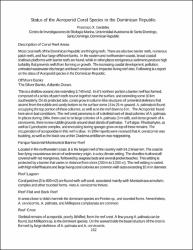/admin/item?itemID=f461ab89-b111-43ea-8354-59f0cd7ee072
Status of the acroporid coral species in the Dominican Republic

Ver/
Tipo de acceso
AbiertoTipo de Material
ArtículoTipo de Contenido
Investigación científicaIdioma
InglésAudiencia
Técnicos, profesionales y científicosColección
- Investigación ambiental [1725]
Metadatos
Mostrar el registro completo del ítem| Sinopsis: | Most coral reefs of the Dominican Republic are fringing reefs. There are also two barrier reefs, numerous patch reefs, and four large offshore banks. In the eastern and northwestern coasts, broad coastal shallow platforms with barrier reefs are found, while in other places terrigenous sediments produce high turbidity that prevents reefs from forming or growing. The increasing coastal development, pollution, untreated wastewater discharges, and beach erosion have impacted living reef sites. Following is a report on the status of Acroporid species in the Dominican Republic. |
| Autor(es): | Geraldes, Francisco X.
|
| Año: | 2003 |
| Publicado: | Proceedings of the Caribbean Acropora Workshop: Potential Application of the U.S. Endangered Species Act as a Conservation Strategy. NOAA Technical Memorandum NMFS-OPR-24 (pp. 152-155). Silver Spring, USA: National Oceanic and Atmospheric Administration |
| Citación: | Geraldes, F. X. (2003). Status of the acroporid coral species in the Dominican Republic. Proceedings of the Caribbean Acropora Workshop: Potential Application of the U.S. Endangered Species Act as a Conservation Strategy. NOAA Technical Memorandum NMFS-OPR-24 (pp. 152-155). Silver Spring, USA: National Oceanic and Atmospheric Administration. Recuperado de: |
| URI: | https://bvearmb.do/handle/123456789/5853
|

